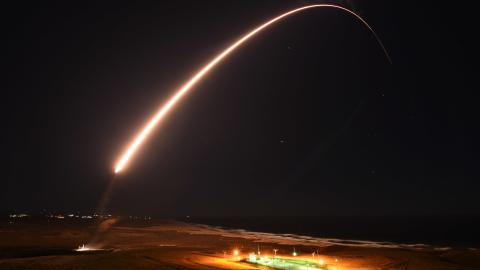The current administration seeks to make space a public policy priority. The re-establishment of the National Space Council and the administration’s announcement earlier this month to prioritize the return of astronauts to the moon have signaled this.
The 2017 National Security Strategy (NSS), which prioritizes U.S. leadership in military, commercial, and scientific components of space, is no exception to the administration’s continued desire to “make America great again in space.” As space evolves into a more globally competitive industry, the economic vitality of the U.S. space sector will support key national security goals to “promote American prosperity” and “advance American influence.”
The NSS, issued every four years, sets the tone for the administration’s national security policy. As John Yoo noted in a recent op-ed for The Hill, the 2017 NSS is stern on matters of security, a posture intended for countries like Russia and China, who have been increasingly bold and occasionally aggressive space players in recent years. This hardline approach to space conflict is a departure from positions issued by the previous administration.
The strategy accentuates the administration’s intention to brand the domestic economy a key component of its U.S. national security strategy. Analysts are predicting that the space industry will be worth anywhere from $1.1 to $2.7 trillion in the next few decades. While unveiling the strategy, President Trump declared that “economic vitality, growth, and prosperity at home is absolutely necessary for American power and influence abroad.” This highlights the abundant economic opportunities available by the uptick in the space industry, and prioritizes ways to maintain U.S. leadership in space and encourage a healthy domestic space sector.
To achieve the policy priorities of the 2017 NSS, the Trump administration must make good on its promises. The strategy lists three priority actions — to “advance space as a priority domain,” “promote space commerce,” and “maintain leadership in exploration” — and seeks to achieve these priorities through regulatory reform, public-private partnerships, and by leveraging the National Space Council to develop goals and strategies and promote innovation.
The NSS is wise to promote space commerce through regulatory reform. As access to space becomes cheaper and the options for launch vehicles, satellites, and other space-faring objects diversify, the regulations will need to be restructured to address the challenges arising from a re-energized industry.
The Federal Aviation Administration (FAA), the governing body of commercial spaceflight, has already taken steps to address regulatory reform with their “21st century licensing process.” Recommendations include streamlining the launch licensing process and developing licenses for newer launch vehicles and “non-traditional” space applications, like satellite servicing technology.
The industry would also benefit from updating an often lengthy commercial remote sensing licensing process. These reforms have been supported by National Geospatial-Intelligence Agency Director Robert Cardillo and by the House Science Committee, which approved the American Space Commerce Free Enterprise Act in June to streamline the licensing process.
Public-private partnerships have the potential to attain both scientific and commercial goals in space. The National Aeronautics and Space Administration (NASA) and the U.S. Department of Defense are well suited to facilitate these partnerships, and much work has been done by these agencies to foster a healthy cost-sharing relationship between the federal government and the commercial space industry. Industry has also lobbiedgovernment on new ways that long-term scientific goals could benefitfrom these types of partnerships. By distributing the cost across multiple entities, the U.S. could achieve grander goals more quickly and cost-effectively.
The National Space Council is in a unique position to influence these priorities. By uniting the regulatory agencies involved in space and providing industry experts a platform to directly advise on reforms, the council can help facilitate a regulatory environment conducive to American competitiveness, innovation, and national security priorities in space.
With the 2017 NSS, the Trump administration establishes the pillars of its national security strategy and outlines ways the economic advantages of the U.S. space sector can be leveraged to support this agenda. As we shift into a booming space era fit for the 21st century, the administration needs to now turn these priorities into actions to achieve these national security goals and maintain U.S. leadership and competitiveness in space.





















